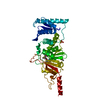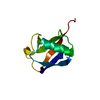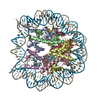+ Open data
Open data
- Basic information
Basic information
| Entry | Database: PDB / ID: 6nn6 | |||||||||
|---|---|---|---|---|---|---|---|---|---|---|
| Title | Structure of Dot1L-H2BK120ub nucleosome complex | |||||||||
 Components Components |
| |||||||||
 Keywords Keywords |  GENE REGULATION / GENE REGULATION /  chromatin / chromatin /  structural biology / structural biology /  single particle / single particle /  cryo-EM / cryo-EM /  histone methyltransferase / histone methyltransferase /  nucleosome / nucleosome /  Dot1L Dot1L | |||||||||
| Function / homology |  Function and homology information Function and homology information: / histone H3K79 trimethyltransferase activity / [histone H3]-lysine79 N-trimethyltransferase / histone H3K79 methyltransferase activity / regulation of transcription regulatory region DNA binding / histone H3 methyltransferase activity / regulation of receptor signaling pathway via JAK-STAT /  histone methyltransferase activity / heterochromatin formation / telomere organization ...: / histone H3K79 trimethyltransferase activity / [histone H3]-lysine79 N-trimethyltransferase / histone H3K79 methyltransferase activity / regulation of transcription regulatory region DNA binding / histone H3 methyltransferase activity / regulation of receptor signaling pathway via JAK-STAT / histone methyltransferase activity / heterochromatin formation / telomere organization ...: / histone H3K79 trimethyltransferase activity / [histone H3]-lysine79 N-trimethyltransferase / histone H3K79 methyltransferase activity / regulation of transcription regulatory region DNA binding / histone H3 methyltransferase activity / regulation of receptor signaling pathway via JAK-STAT /  histone methyltransferase activity / heterochromatin formation / telomere organization / DNA damage checkpoint signaling / PKMTs methylate histone lysines / structural constituent of chromatin / histone methyltransferase activity / heterochromatin formation / telomere organization / DNA damage checkpoint signaling / PKMTs methylate histone lysines / structural constituent of chromatin /  nucleosome / nucleosome /  gene expression / RNA polymerase II-specific DNA-binding transcription factor binding / gene expression / RNA polymerase II-specific DNA-binding transcription factor binding /  nucleic acid binding / nucleic acid binding /  transcription coactivator activity / protein heterodimerization activity / transcription coactivator activity / protein heterodimerization activity /  DNA repair / intracellular membrane-bounded organelle / positive regulation of cell population proliferation / positive regulation of transcription by RNA polymerase II / protein-containing complex / DNA repair / intracellular membrane-bounded organelle / positive regulation of cell population proliferation / positive regulation of transcription by RNA polymerase II / protein-containing complex /  DNA binding / DNA binding /  nucleoplasm / nucleoplasm /  nucleus / nucleus /  cytoplasm cytoplasmSimilarity search - Function | |||||||||
| Biological species |  Xenopus laevis (African clawed frog) Xenopus laevis (African clawed frog)  Homo sapiens (human) Homo sapiens (human)synthetic construct (others) | |||||||||
| Method |  ELECTRON MICROSCOPY / ELECTRON MICROSCOPY /  single particle reconstruction / single particle reconstruction /  cryo EM / Resolution: 3.9 Å cryo EM / Resolution: 3.9 Å | |||||||||
 Authors Authors | Anderson, C.J. / Baird, M.R. / Hsu, A. / Barbour, E.H. / Koyama, Y. / Borgnia, M.J. / McGinty, R.K. | |||||||||
| Funding support |  United States, 2items United States, 2items
| |||||||||
 Citation Citation |  Journal: Cell Rep / Year: 2019 Journal: Cell Rep / Year: 2019Title: Structural Basis for Recognition of Ubiquitylated Nucleosome by Dot1L Methyltransferase. Authors: Cathy J Anderson / Matthew R Baird / Allen Hsu / Emily H Barbour / Yuka Koyama / Mario J Borgnia / Robert K McGinty /  Abstract: Histone H3 lysine 79 (H3K79) methylation is enriched on actively transcribed genes, and its misregulation is a hallmark of leukemia. Methylation of H3K79, which resides on the structured disk face of ...Histone H3 lysine 79 (H3K79) methylation is enriched on actively transcribed genes, and its misregulation is a hallmark of leukemia. Methylation of H3K79, which resides on the structured disk face of the nucleosome, is mediated by the Dot1L methyltransferase. Dot1L activity is part of a trans-histone crosstalk pathway, requiring prior histone H2B ubiquitylation of lysine 120 (H2BK120ub) for optimal activity. However, the molecular details describing both how Dot1L binds to the nucleosome and why Dot1L is activated by H2BK120 ubiquitylation are unknown. Here, we present the cryoelectron microscopy (cryo-EM) structure of Dot1L bound to a nucleosome reconstituted with site-specifically ubiquitylated H2BK120. The structure reveals that Dot1L engages the nucleosome acidic patch using a variant arginine anchor and occupies a conformation poised for methylation. In this conformation, Dot1L and ubiquitin interact directly through complementary hydrophobic surfaces. This study establishes a path to better understand Dot1L function in normal and leukemia cells. | |||||||||
| History |
|
- Structure visualization
Structure visualization
| Movie |
 Movie viewer Movie viewer |
|---|---|
| Structure viewer | Molecule:  Molmil Molmil Jmol/JSmol Jmol/JSmol |
- Downloads & links
Downloads & links
- Download
Download
| PDBx/mmCIF format |  6nn6.cif.gz 6nn6.cif.gz | 353.4 KB | Display |  PDBx/mmCIF format PDBx/mmCIF format |
|---|---|---|---|---|
| PDB format |  pdb6nn6.ent.gz pdb6nn6.ent.gz | 269.3 KB | Display |  PDB format PDB format |
| PDBx/mmJSON format |  6nn6.json.gz 6nn6.json.gz | Tree view |  PDBx/mmJSON format PDBx/mmJSON format | |
| Others |  Other downloads Other downloads |
-Validation report
| Arichive directory |  https://data.pdbj.org/pub/pdb/validation_reports/nn/6nn6 https://data.pdbj.org/pub/pdb/validation_reports/nn/6nn6 ftp://data.pdbj.org/pub/pdb/validation_reports/nn/6nn6 ftp://data.pdbj.org/pub/pdb/validation_reports/nn/6nn6 | HTTPS FTP |
|---|
-Related structure data
| Related structure data |  0458MC  0459C  0460C M: map data used to model this data C: citing same article ( |
|---|---|
| Similar structure data |
- Links
Links
- Assembly
Assembly
| Deposited unit | 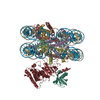
|
|---|---|
| 1 |
|
- Components
Components
-Protein , 6 types, 10 molecules AEBFCGDHKL
| #1: Protein | Mass: 15303.930 Da / Num. of mol.: 2 / Mutation: G103A Source method: isolated from a genetically manipulated source Source: (gene. exp.)  Xenopus laevis (African clawed frog) / Plasmid: pET3a / Production host: Xenopus laevis (African clawed frog) / Plasmid: pET3a / Production host:   Escherichia coli (E. coli) / Strain (production host): BL21(DE3)pLysS / References: UniProt: P84233 Escherichia coli (E. coli) / Strain (production host): BL21(DE3)pLysS / References: UniProt: P84233#2: Protein |  Mass: 11263.231 Da / Num. of mol.: 2 Source method: isolated from a genetically manipulated source Source: (gene. exp.)  Xenopus laevis (African clawed frog) / Plasmid: pET3a / Production host: Xenopus laevis (African clawed frog) / Plasmid: pET3a / Production host:   Escherichia coli (E. coli) / Strain (production host): BL21(DE3)pLysS / References: UniProt: P62799 Escherichia coli (E. coli) / Strain (production host): BL21(DE3)pLysS / References: UniProt: P62799#3: Protein | Mass: 13978.241 Da / Num. of mol.: 2 / Mutation: G100R, A124S Source method: isolated from a genetically manipulated source Source: (gene. exp.)  Xenopus laevis (African clawed frog) / Plasmid: pET3a / Production host: Xenopus laevis (African clawed frog) / Plasmid: pET3a / Production host:   Escherichia coli (E. coli) / Strain (production host): BL21(DE3)pLysS / References: UniProt: P06897 Escherichia coli (E. coli) / Strain (production host): BL21(DE3)pLysS / References: UniProt: P06897#4: Protein | Mass: 13642.846 Da / Num. of mol.: 2 / Mutation: S33T, K121C Source method: isolated from a genetically manipulated source Source: (gene. exp.)  Xenopus laevis (African clawed frog) / Plasmid: pET3a / Production host: Xenopus laevis (African clawed frog) / Plasmid: pET3a / Production host:   Escherichia coli (E. coli) / Strain (production host): BL21(DE3)pLysS / References: UniProt: P02281 Escherichia coli (E. coli) / Strain (production host): BL21(DE3)pLysS / References: UniProt: P02281#7: Protein | |  Histone methyltransferase / DOT1-like protein / Histone H3-K79 methyltransferase / H3-K79-HMTase / Lysine N-methyltransferase 4 Histone methyltransferase / DOT1-like protein / Histone H3-K79 methyltransferase / H3-K79-HMTase / Lysine N-methyltransferase 4Mass: 47462.039 Da / Num. of mol.: 1 Source method: isolated from a genetically manipulated source Source: (gene. exp.)   Homo sapiens (human) / Gene: DOT1L, KIAA1814, KMT4 / Plasmid: pST50 / Production host: Homo sapiens (human) / Gene: DOT1L, KIAA1814, KMT4 / Plasmid: pST50 / Production host:   Escherichia coli (E. coli) / Strain (production host): BL21(DE3)pLysS Escherichia coli (E. coli) / Strain (production host): BL21(DE3)pLysSReferences: UniProt: Q8TEK3,  histone-lysine N-methyltransferase histone-lysine N-methyltransferase#8: Protein | |  Mass: 8911.180 Da / Num. of mol.: 1 / Mutation: G76S Source method: isolated from a genetically manipulated source Source: (gene. exp.)   Homo sapiens (human) / Gene: UBC / Plasmid: pST50 / Production host: Homo sapiens (human) / Gene: UBC / Plasmid: pST50 / Production host:   Escherichia coli (E. coli) / Strain (production host): BL21(DE3)pLysS / References: UniProt: F5H388 Escherichia coli (E. coli) / Strain (production host): BL21(DE3)pLysS / References: UniProt: F5H388 |
|---|
-DNA chain , 2 types, 2 molecules IJ
| #5: DNA chain | Mass: 44520.383 Da / Num. of mol.: 1 / Source method: obtained synthetically / Details: Widom 601 nucleosome positioning sequence / Source: (synth.) synthetic construct (others) |
|---|---|
| #6: DNA chain | Mass: 44991.660 Da / Num. of mol.: 1 / Source method: obtained synthetically / Details: Widom 601 nucleosome positioning sequence / Source: (synth.) synthetic construct (others) |
-Experimental details
-Experiment
| Experiment | Method:  ELECTRON MICROSCOPY ELECTRON MICROSCOPY |
|---|---|
| EM experiment | Aggregation state: PARTICLE / 3D reconstruction method:  single particle reconstruction single particle reconstruction |
- Sample preparation
Sample preparation
| Component | Name: Dot1L-H2BK120ub nucleosome complex (Class 2A) / Type: COMPLEX / Entity ID: all / Source: RECOMBINANT |
|---|---|
| Molecular weight | Value: 0.27 MDa / Experimental value: NO |
| Source (natural) | Organism:   Homo sapiens (human) Homo sapiens (human) |
| Source (recombinant) | Organism:   Escherichia coli (E. coli) Escherichia coli (E. coli) |
| Buffer solution | pH: 7.5 |
| Specimen | Conc.: 0.93 mg/ml / Embedding applied: NO / Shadowing applied: NO / Staining applied : NO / Vitrification applied : NO / Vitrification applied : YES : YES |
| Specimen support | Grid material: COPPER / Grid mesh size: 300 divisions/in. / Grid type: Quantifoil R1.2/1.3 |
Vitrification | Instrument: FEI VITROBOT MARK IV / Cryogen name: ETHANE / Humidity: 100 % / Chamber temperature: 277.15 K |
- Electron microscopy imaging
Electron microscopy imaging
| Experimental equipment |  Model: Titan Krios / Image courtesy: FEI Company |
|---|---|
| Microscopy | Model: FEI TITAN KRIOS |
| Electron gun | Electron source : :  FIELD EMISSION GUN / Accelerating voltage: 300 kV / Illumination mode: FLOOD BEAM FIELD EMISSION GUN / Accelerating voltage: 300 kV / Illumination mode: FLOOD BEAM |
| Electron lens | Mode: BRIGHT FIELD Bright-field microscopy Bright-field microscopy |
| Image recording | Average exposure time: 60 sec. / Electron dose: 48 e/Å2 / Detector mode: COUNTING / Film or detector model: FEI FALCON III (4k x 4k) / Num. of grids imaged: 1 / Num. of real images: 1000 |
- Processing
Processing
| EM software |
| ||||||||||||||||||||||||||||||||||||||||||||||||||||||||||||||||||||||||||||||
|---|---|---|---|---|---|---|---|---|---|---|---|---|---|---|---|---|---|---|---|---|---|---|---|---|---|---|---|---|---|---|---|---|---|---|---|---|---|---|---|---|---|---|---|---|---|---|---|---|---|---|---|---|---|---|---|---|---|---|---|---|---|---|---|---|---|---|---|---|---|---|---|---|---|---|---|---|---|---|---|
CTF correction | Type: PHASE FLIPPING AND AMPLITUDE CORRECTION | ||||||||||||||||||||||||||||||||||||||||||||||||||||||||||||||||||||||||||||||
| Particle selection | Num. of particles selected: 408526 | ||||||||||||||||||||||||||||||||||||||||||||||||||||||||||||||||||||||||||||||
| Symmetry | Point symmetry : C1 (asymmetric) : C1 (asymmetric) | ||||||||||||||||||||||||||||||||||||||||||||||||||||||||||||||||||||||||||||||
3D reconstruction | Resolution: 3.9 Å / Resolution method: FSC 0.143 CUT-OFF / Num. of particles: 39558 / Num. of class averages: 1 / Symmetry type: POINT | ||||||||||||||||||||||||||||||||||||||||||||||||||||||||||||||||||||||||||||||
| Atomic model building | Protocol: RIGID BODY FIT / Space: REAL | ||||||||||||||||||||||||||||||||||||||||||||||||||||||||||||||||||||||||||||||
| Atomic model building | 3D fitting-ID: 1 / Source name: PDB / Type: experimental model
|
 Movie
Movie Controller
Controller



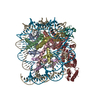
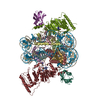
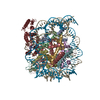

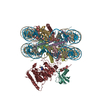
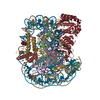


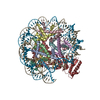

 PDBj
PDBj






































